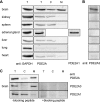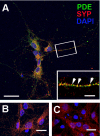Dual acylation of PDE2A splice variant 3: targeting to synaptic membranes
- PMID: 19632989
- PMCID: PMC2757980
- DOI: 10.1074/jbc.M109.017194
Dual acylation of PDE2A splice variant 3: targeting to synaptic membranes
Abstract
The cGMP-stimulated PDE2A hydrolyzes both cyclic nucleotides, cGMP and cAMP. Three splice variants have been cloned from several species. Whereas PDE2A1 is soluble, PDE2A2 and PDE2A3 are membrane-bound enzymes of rat and bovine origin, respectively. To date it is unclear whether one species expresses all three variants. The splice variants only differ in their N termini, which likely determine the subcellular localization. However, the mechanism for membrane attachment remains unknown. Here, we show that myristoylation underlies membrane targeting of PDE2A3. The myristoylated enzyme was bound to plasma membranes, whereas mutation of the myristoyl recipient Gly2 prevented incorporation of [3H]myristate and turned PDE2A3 completely soluble. Additionally, Cys5 and to a minor extent Cys11 are required for targeting of PDE2A3. Substitution of the putatively palmitoylated cysteines partially solubilized the enzyme and led to an accumulation in the endoplasmic reticulum/Golgi compartment, as shown by fluorescence microscopy in HEK 293 and PC12 cells. In vivo, PDE2A is expressed in many tissues. By using newly generated antibodies selectively detecting the splice variants PDE2A3 or PDE2A1, respectively, we demonstrate on the protein level PDE2A3 expression in mouse brain where it is entirely membrane-associated and a widespread expression of soluble PDE2A1 in mouse tissues. We show that PDE2A localizes to synaptosomal membranes and in primary cultures of hippocampal neurons partially overlaps with the presynaptic marker synaptophysin as demonstrated by immunofluorescence. In sum, these results demonstrate dual acylation as mechanism targeting neuronal PDE2A3 to synapses thereby ensuring local control of cyclic nucleotides.
Figures







Similar articles
-
Isolation and characterization of human cDNAs encoding a cGMP-stimulated 3',5'-cyclic nucleotide phosphodiesterase.Gene. 1997 May 20;191(1):89-95. doi: 10.1016/s0378-1119(97)00046-2. Gene. 1997. PMID: 9210593
-
Inhibition of PDE2A, but not PDE9A, modulates presynaptic short-term plasticity measured by paired-pulse facilitation in the CA1 region of the hippocampus.Synapse. 2015 Oct;69(10):484-96. doi: 10.1002/syn.21840. Epub 2015 Jul 29. Synapse. 2015. PMID: 26178667
-
Functional roles for fatty acylated amino-terminal domains in subcellular localization.Mol Biol Cell. 1999 Nov;10(11):3771-86. doi: 10.1091/mbc.10.11.3771. Mol Biol Cell. 1999. PMID: 10564270 Free PMC article.
-
Role of Phosphodiesterases on the Function of Aryl Hydrocarbon Receptor-Interacting Protein (AIP) in the Pituitary Gland and on the Evaluation of AIP Gene Variants.Horm Metab Res. 2017 Apr;49(4):286-295. doi: 10.1055/s-0043-104700. Epub 2017 Apr 20. Horm Metab Res. 2017. PMID: 28427099 Review.
-
Towards selective phosphodiesterase 2A (PDE2A) inhibitors: a patent review (2010 - present).Expert Opin Ther Pat. 2016 Aug;26(8):933-46. doi: 10.1080/13543776.2016.1203902. Epub 2016 Jun 30. Expert Opin Ther Pat. 2016. PMID: 27321640 Review.
Cited by
-
The distribution of phosphodiesterase 2A in the rat brain.Neuroscience. 2012 Dec 13;226:145-55. doi: 10.1016/j.neuroscience.2012.09.011. Epub 2012 Sep 19. Neuroscience. 2012. PMID: 23000621 Free PMC article.
-
Advances in targeting cyclic nucleotide phosphodiesterases.Nat Rev Drug Discov. 2014 Apr;13(4):290-314. doi: 10.1038/nrd4228. Nat Rev Drug Discov. 2014. PMID: 24687066 Free PMC article. Review.
-
Phosphodiesterases and Compartmentation of cAMP and cGMP Signaling in Regulation of Cardiac Contractility in Normal and Failing Hearts.Int J Mol Sci. 2022 Feb 15;23(4):2145. doi: 10.3390/ijms23042145. Int J Mol Sci. 2022. PMID: 35216259 Free PMC article. Review.
-
Cyclic AMP control measured in two compartments in HEK293 cells: phosphodiesterase K(M) is more important than phosphodiesterase localization.PLoS One. 2011;6(9):e24392. doi: 10.1371/journal.pone.0024392. Epub 2011 Sep 8. PLoS One. 2011. PMID: 21931705 Free PMC article.
-
Compartmentalized cAMP signalling and control of cardiac rhythm.Philos Trans R Soc Lond B Biol Sci. 2023 Jun 19;378(1879):20220172. doi: 10.1098/rstb.2022.0172. Epub 2023 May 1. Philos Trans R Soc Lond B Biol Sci. 2023. PMID: 37122225 Free PMC article. Review.
References
-
- Bender A. T., Beavo J. A. (2006) Pharmacol. Rev. 58, 488–520 - PubMed
-
- Martins T. J., Mumby M. C., Beavo J. A. (1982) J. Biol. Chem. 257, 1973–1979 - PubMed
-
- Beavo J. A., Hardman J. G., Sutherland E. W. (1971) J. Biol. Chem. 246, 3841–3846 - PubMed
-
- Erneux C., Couchie D., Dumont J. E., Baraniak J., Stec W. J., Abbad E. G., Petridis G., Jastorff B. (1981) Eur. J. Biochem. 115, 503–510 - PubMed
-
- MacFarland R. T., Zelus B. D., Beavo J. A. (1991) J. Biol. Chem. 266, 136–142 - PubMed
Publication types
MeSH terms
Substances
LinkOut - more resources
Full Text Sources
Molecular Biology Databases
Miscellaneous

